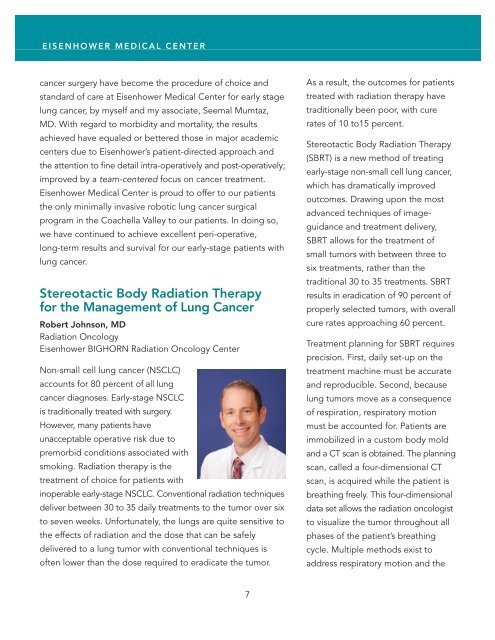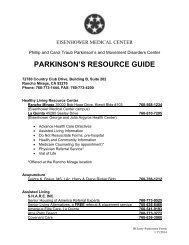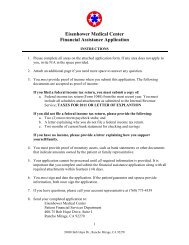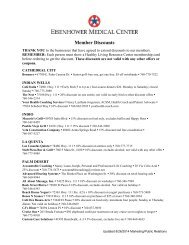Cancer Program Annual Report - Eisenhower Medical Center
Cancer Program Annual Report - Eisenhower Medical Center
Cancer Program Annual Report - Eisenhower Medical Center
You also want an ePaper? Increase the reach of your titles
YUMPU automatically turns print PDFs into web optimized ePapers that Google loves.
E I S E N H O W E R M E D I C A L C E N T E R<br />
cancer surgery have become the procedure of choice and<br />
standard of care at <strong>Eisenhower</strong> <strong>Medical</strong> <strong>Center</strong> for early stage<br />
lung cancer, by myself and my associate, Seemal Mumtaz,<br />
MD. With regard to morbidity and mortality, the results<br />
achieved have equaled or bettered those in major academic<br />
centers due to <strong>Eisenhower</strong>’s patient-directed approach and<br />
the attention to fine detail intra-operatively and post-operatively;<br />
improved by a team-centered focus on cancer treatment.<br />
<strong>Eisenhower</strong> <strong>Medical</strong> <strong>Center</strong> is proud to offer to our patients<br />
the only minimally invasive robotic lung cancer surgical<br />
program in the Coachella Valley to our patients. In doing so,<br />
we have continued to achieve excellent peri-operative,<br />
long-term results and survival for our early-stage patients with<br />
lung cancer.<br />
Stereotactic Body Radiation Therapy<br />
for the Management of Lung <strong>Cancer</strong><br />
Robert Johnson, MD<br />
Radiation Oncology<br />
<strong>Eisenhower</strong> BIGHORN Radiation Oncology <strong>Center</strong><br />
Non-small cell lung cancer (NSCLC)<br />
accounts for 80 percent of all lung<br />
cancer diagnoses. Early-stage NSCLC<br />
is traditionally treated with surgery.<br />
However, many patients have<br />
unacceptable operative risk due to<br />
premorbid conditions associated with<br />
smoking. Radiation therapy is the<br />
treatment of choice for patients with<br />
inoperable early-stage NSCLC. Conventional radiation techniques<br />
deliver between 30 to 35 daily treatments to the tumor over six<br />
to seven weeks. Unfortunately, the lungs are quite sensitive to<br />
the effects of radiation and the dose that can be safely<br />
delivered to a lung tumor with conventional techniques is<br />
often lower than the dose required to eradicate the tumor.<br />
As a result, the outcomes for patients<br />
treated with radiation therapy have<br />
traditionally been poor, with cure<br />
rates of 10 to15 percent.<br />
Stereotactic Body Radiation Therapy<br />
(SBRT) is a new method of treating<br />
early-stage non-small cell lung cancer,<br />
which has dramatically improved<br />
outcomes. Drawing upon the most<br />
advanced techniques of imageguidance<br />
and treatment delivery,<br />
SBRT allows for the treatment of<br />
small tumors with between three to<br />
six treatments, rather than the<br />
traditional 30 to 35 treatments. SBRT<br />
results in eradication of 90 percent of<br />
properly selected tumors, with overall<br />
cure rates approaching 60 percent.<br />
Treatment planning for SBRT requires<br />
precision. First, daily set-up on the<br />
treatment machine must be accurate<br />
and reproducible. Second, because<br />
lung tumors move as a consequence<br />
of respiration, respiratory motion<br />
must be accounted for. Patients are<br />
immobilized in a custom body mold<br />
and a CT scan is obtained. The planning<br />
scan, called a four-dimensional CT<br />
scan, is acquired while the patient is<br />
breathing freely. This four-dimensional<br />
data set allows the radiation oncologist<br />
to visualize the tumor throughout all<br />
phases of the patient’s breathing<br />
cycle. Multiple methods exist to<br />
address respiratory motion and the<br />
7













